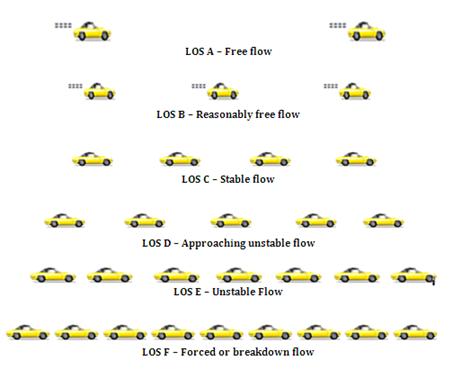Prediction of Future Noise Levels
Based on the proposed highway alignment, MDOT SHA uses a computer program developed by the Federal Highway Administration (FHWA) to forecast the level of noise in the design year, which is typically about 20 years in the future. The computer program uses predicted loudest-hour (worst-case) traffic volumes, the percentage of trucks, and travel speeds to forecast noise levels.
Contrary to popular belief, the worst source of highway noise is not typically a traffic jam. When there is a traffic jam, vehicles do not move as fast as they normally would if there was no jam, and therefore do not make as much noise. The level of service (LOS) of a roadway describes the operating conditions on the facility in terms of traffic performance measures related to speed and travel time, freedom to maneuver, traffic interruptions, comfort and convenience. Levels of service range from LOS A (least congested) to LOS F (most congested) as shown below:
LEVELS OF SERVICE
 Adapted from A Policy on Geometric Design of Highways and Streets. AASHTO. 2001
Adapted from A Policy on Geometric Design of Highways and Streets. AASHTO. 2001
Highway traffic noise is worst in LOS D — this is when the roadway is nearing capacity. Although vehicles may not be moving quickly, they are all moving and are doing so at a steady speed. This is the point at which any more vehicle additions will result in an unstable flow of traffic (stop-and-go traffic).
The computer program also examines distance of the receptors from the proposed highway and physical features such as hills, valleys, buildings, and obstructions that affect how noise would travel to the receptors.
The most recent computer program developed by the FHWA is TNM (Traffic Noise Model) Version 2.5, available through the McTrans Center at the University of Florida.